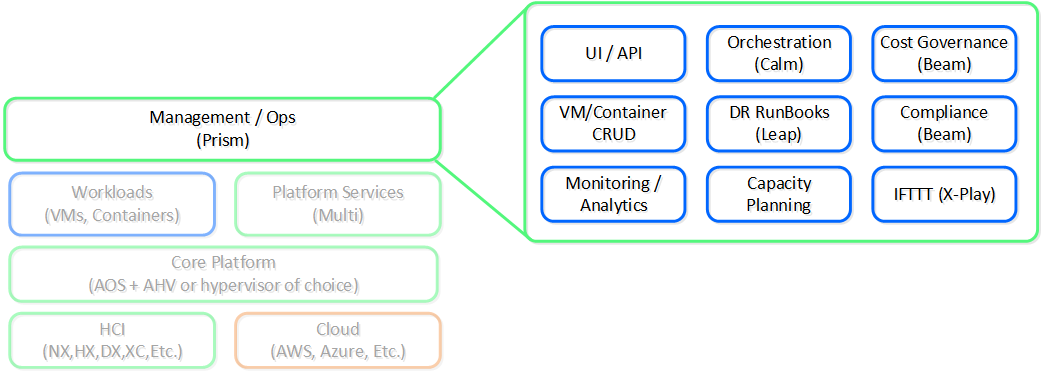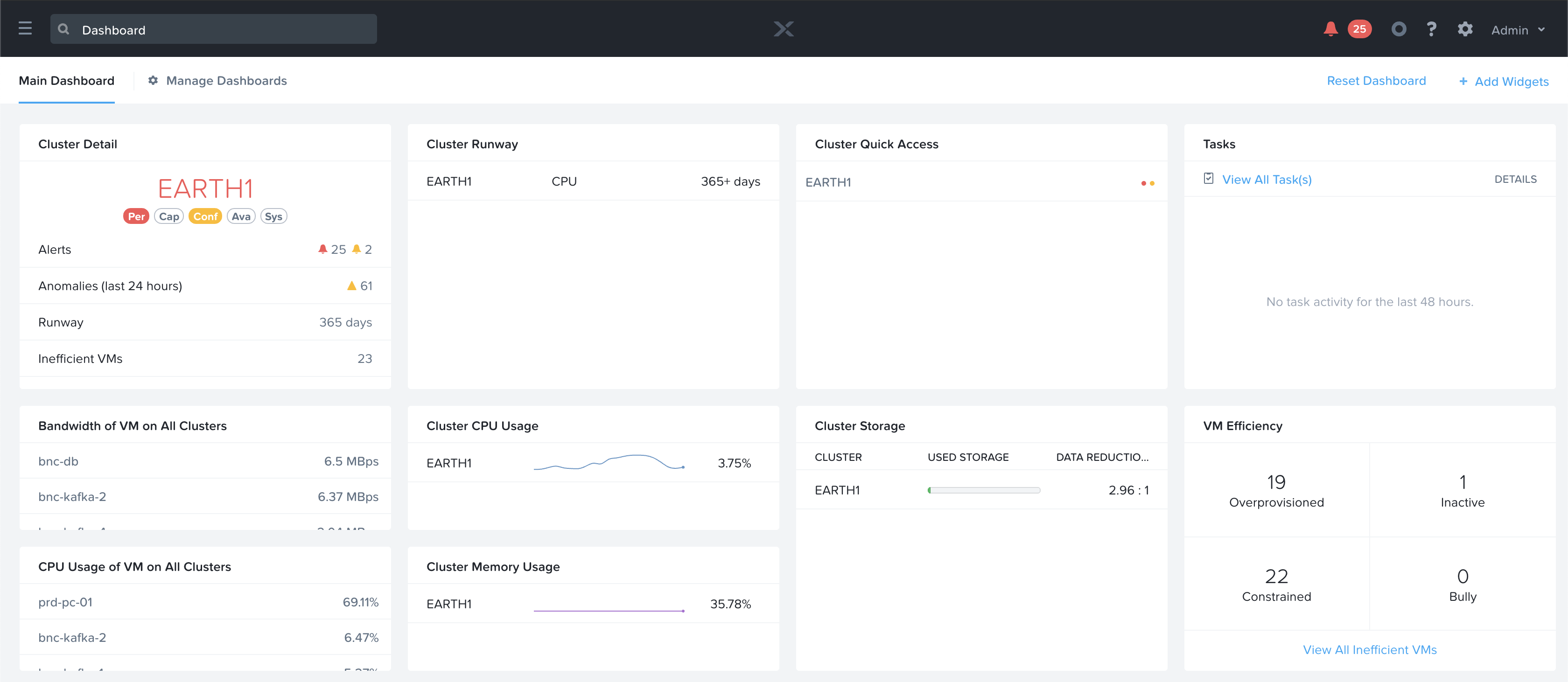Nutanix Basics [Explained]
![Nutanix Basics [Explained]](https://learnduty.com/wp-content/uploads/2021/07/nutanix-platform-circa-2014.png?v=1647900709)
Architecture:

Nutanix in nutshell:
Two component Prism (Management and automation) and Acropolis (Converged compute system)

I- Acropolis:
The Acropolis Operating System (AOS) provides the core functionality leveraged by workloads and services running on the platform. This includes storage services, upgrades, etc.

High-level AOS Architecture
AOS is a back-end service that allows for workload and resource management, provisioning, and operations. Its goal is to abstract the facilitating resource (e.g., hypervisor, on-premise, cloud, etc.) from the workloads running while providing a single “platform” to operate.
Acropolis Explained:
Acropolis does not rely on traditional SAN or NAS storage or expensive storage network
interconnects. It combines highly dense storage and server compute (CPU and RAM) into a
single platform building block. Each building block delivers a unified, scale-out, shared-nothing
architecture with no single points of failure.
The Nutanix solution requires no SAN constructs, such as LUNs, RAID groups, or expensive
storage switches. All storage management is VM-centric, and I/O is optimized at the VM virtual
disk level. The software solution runs on nodes from a variety of manufacturers that are either
all-flash for optimal performance, or a hybrid combination of SSD and HDD that provides a
combination of performance and additional capacity. The DSF automatically tiers data across the
cluster to different classes of storage devices using intelligent data placement algorithms. For
best performance, algorithms make sure the most frequently used data is available in memory or
in flash on the node local to the VM.

The Nutanix solution is converged storage + compute solution which leverages local components and creates a distributed platform for running workloads.
Each node runs an industry-standard hypervisor (ESXi, AHV, Hyper-V and XenServer currently) and the Nutanix Controller VM (CVM). The Nutanix CVM is what runs the Nutanix software and serves all of the I/O operations for the hypervisor and all VMs running on that host.
The following figure provides an example of what a typical node logically looks like:

Converged Platform
The Nutanix CVM is responsible for the core Nutanix platform logic and handles services like:
- Storage I/O & transforms (Deduplication, Compression, EC)
- UI / API
- Upgrades
- DR / Replication
II- Prism:
Prism is a distributed resource management platform which allows users to manage and monitor objects and services across their Nutanix environment, whether hosted locally or in the cloud.
These capabilities are broken down into two key categories:
- Interfaces
- HTML5 UI, REST API, CLI, PowerShell CMDlets, etc.
- Management Capabilities
- Platform management, VM / Container CRUD, policy definition and compliance, service design and status, analytics and monitoring
The following figure illustrates the conceptual nature of Prism as part of the Nutanix platform:

High-Level Prism Architecture
Prism is broken down into two main components:
- Prism Central (PC)
- The multi-cluster manager responsible for managing multiple Nutanix Clusters to provide a single, centralized management interface. Prism Central is an optional software appliance (VM) which can be deployed in addition to the AOS Cluster (can run on it).
- 1-to-many cluster manager
- Prism Element (PE)
- Localized cluster manager responsible for local cluster management and operations. Every Nutanix Cluster has Prism Element built-in.
- 1-to-1 cluster manager
The figure shows an image illustrating the conceptual relationship between Prism Central and Prism Element:

Prism Architecture
Pro tip
For larger or distributed deployments (e.g. more than one cluster or multiple sites) it is recommended to use Prism Central to simplify operations and provide a single management UI for all clusters / sites.
Prism Services
A Prism service runs on every CVM with an elected Prism Leader which is responsible for handling HTTP requests. Similar to other components which have a Leader, if the Prism Leader fails, a new one will be elected. When a CVM which is not the Prism Leader gets a HTTP request it will permanently redirect the request to the current Prism Leader using HTTP response status code 301.
Here we show a conceptual view of the Prism services and how HTTP request(s) are handled:

Prism is fairly straight forward and simple to use, however we’ll cover some of the main pages and basic usage.
Prism Central (if deployed) can be accessed using the IP address specified during configuration or corresponding DNS entry. Prism Element can be accessed via Prism Central (by clicking on a specific cluster) or by navigating to any Nutanix CVM or cluster IP (preferred).
Once the page has been loaded you will be greeted with the Login page where you will use your Prism or Active Directory credentials to login.

Prism Login Page
Upon successful login you will be sent to the dashboard page which will provide overview information for managed cluster(s) in Prism Central or the local cluster in Prism Element.
Prism Central and Prism Element will be covered in more detail in the following sections.
Prism Authentication
Prism currently supports integrations with the following authentication providers:
- Prism Element (PE)
- Local
- Active Directory
- LDAP
- Prism Central (PC)
- Local
- Active Directory
- LDAP
- SAML Authn (IDP)
Prism Central
The figure shows a sample Prism Central dashboard where multiple clusters can be monitored / managed:

Prism Central – Dashboard
From here you can monitor the overall status of your environment, and dive deeper if there are any alerts or items of interest.
Prism Central contains the following main pages (NOTE: Search is the preferred / recommended method to navigation):
- Home Page
- Environment wide monitoring dashboard including detailed information on service status, capacity planning, performance, tasks, etc. To get further information on any of them you can click on the item of interest.
- Virtual Infrastructure
- Virtual entities (e.g. VMs, containers, Images, categories, etc.)
- Policies
- Policy management and creation (e.g. security (FLOW), Protection (Backup/Replication), Recovery (DR), NGT)
- Hardware
- Physical devices management (e.g. clusters, hosts, disks, GPU)
- Activity
- Environment wide alerts, events and tasks
- Operations
- Operations dashboards, reporting and actions (X-Play)
- Administration
- Environment construct management (e.g. users, groups, roles, availability zones)
- Services
- Add-on service management (e.g. Calm, Karbon)
- Settings
- Prism Central configuration
Bilel.
Reference: https://nutanixbible.com/



![OSPF DR and BDR Election Explained [with Configuration]](https://learnduty.com/wp-content/uploads/2022/03/image-33.png?v=1647900046)
![OSPF Neighbor Adjacency Requirements [With Configuration]](https://learnduty.com/wp-content/uploads/2022/03/image-23-418x450.png?v=1647900064)
![OSPF Neighbor States Explained [Step by Step]](https://learnduty.com/wp-content/uploads/2022/03/image-13.png?v=1647900076)